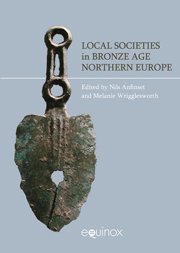Book contents
- Frontmatter
- Contents
- List of figures and tables
- Contributors
- Acknowledgements
- Introduction: local societies, regions and processes of cultural interaction in the Bronze Age
- PART I IDENTITY, GRAND NARRATIVES AND NETWORKS
- PART II REGIONS, GLOBALIZATION AND RESISTANCE
- 7 Northwestern Russia at the periphery of the north European and Volga-Uralic Bronze Age
- 8 Local centres in the periphery: the Late Neolithic, Bronze Age and Early Metal Age in Finland
- 9 The Nordic Bronze Age and the Lüneburg culture: two different responses to social change
- 10 Pottery, transmission and innovation in Mälardalen
- 11 Social landscapes of Bronze Age Scandinavia
- 12 The origin of a Bronze Age in Norway: structure, regional process and localized history
- 13 Social response or resistance to the introduction of metal? Western Norway at the edge of the “globalized” world
- Index
9 - The Nordic Bronze Age and the Lüneburg culture: two different responses to social change
from PART II - REGIONS, GLOBALIZATION AND RESISTANCE
- Frontmatter
- Contents
- List of figures and tables
- Contributors
- Acknowledgements
- Introduction: local societies, regions and processes of cultural interaction in the Bronze Age
- PART I IDENTITY, GRAND NARRATIVES AND NETWORKS
- PART II REGIONS, GLOBALIZATION AND RESISTANCE
- 7 Northwestern Russia at the periphery of the north European and Volga-Uralic Bronze Age
- 8 Local centres in the periphery: the Late Neolithic, Bronze Age and Early Metal Age in Finland
- 9 The Nordic Bronze Age and the Lüneburg culture: two different responses to social change
- 10 Pottery, transmission and innovation in Mälardalen
- 11 Social landscapes of Bronze Age Scandinavia
- 12 The origin of a Bronze Age in Norway: structure, regional process and localized history
- 13 Social response or resistance to the introduction of metal? Western Norway at the edge of the “globalized” world
- Index
Summary
Introduction
It is often taken for granted in archaeological research projects that regions and their boundaries remain the same over time. Is this really true? Do different areas within a cultural geographical zone always respond in the same manner to new impulses or can the view of belonging to the same or similar culture change over time? This chapter aims to discuss the response to the new innovation of bronze within some areas in northern Europe: the so-called Nordic Bronze Age and the Lüneburg culture, mainly during the Middle Bronze Age (1600–1300 bce). In order to compare the regions, central European chronological terms are used if nothing else is stated. The chapter builds on the author's PhD dissertation.
Regions and regionality
What are regional studies in archaeology? In a recent article by Kanter (2008) the concept is more or less equated with settlement studies in a larger environment, or what is alternatively called landscape archaeology. Kanter identifies a difference between the North American and European use of settlement archaeology. That is, European landscape archaeology encompasses a wider interest than that of North America, which focuses on spatial and ecological relationships, and European research includes other perspectives such as how people perceived their landscape, and so on (Kanter 2008: 38–41). But is it really that simple? Do and should regional studies in archaeology always discuss settlement patterns, even if including how people perceive it? Are there no other interesting regional patterns?
- Type
- Chapter
- Information
- Local Societies in Bronze Age Northern Europe , pp. 169 - 184Publisher: Acumen PublishingPrint publication year: 2012

